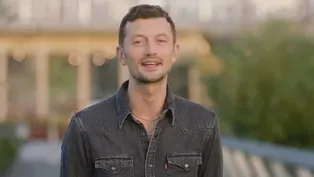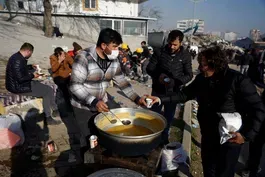
The current hurdles to putting more EVs on the road
Clip: 2/12/2023 | 6m 37sVideo has Closed Captions
The current hurdles to putting more electric vehicles on the road
In last week's State of the Union, President Biden reaffirmed his administration's commitment to get more electric vehicles in American driveways. It's estimated that half of all new vehicle sales will be EVs by 2030, but the industry still faces infrastructure hurdles, policy challenges and public misconceptions. Forbes senior transportation editor Alan Ohnsman joins William Brangham to discuss.
Problems with Closed Captions? Closed Captioning Feedback
Problems with Closed Captions? Closed Captioning Feedback
Major corporate funding for the PBS News Hour is provided by BDO, BNSF, Consumer Cellular, American Cruise Lines, and Raymond James. Funding for the PBS NewsHour Weekend is provided by...

The current hurdles to putting more EVs on the road
Clip: 2/12/2023 | 6m 37sVideo has Closed Captions
In last week's State of the Union, President Biden reaffirmed his administration's commitment to get more electric vehicles in American driveways. It's estimated that half of all new vehicle sales will be EVs by 2030, but the industry still faces infrastructure hurdles, policy challenges and public misconceptions. Forbes senior transportation editor Alan Ohnsman joins William Brangham to discuss.
Problems with Closed Captions? Closed Captioning Feedback
How to Watch PBS News Hour
PBS News Hour is available to stream on pbs.org and the free PBS App, available on iPhone, Apple TV, Android TV, Android smartphones, Amazon Fire TV, Amazon Fire Tablet, Roku, Samsung Smart TV, and Vizio.
Providing Support for PBS.org
Learn Moreabout PBS online sponsorshipThe Biden administration wants to see more electric vehicles in American driveways, a commitment reaffirmed in the State of the Union address.
It's estimated that by 2030, half of all new vehicle sales will be electric vehicles.
William Brangham looks at the infrastructure hurdles, policy challenges, and public misconceptions facing electric vehicles.
WILLIAM BRANGHAM: This move toward vehicles powered by electricity instead of gas has obvious benefits for tackling climate change.
Transportation overall accounts for roughly a third of America's carbon emissions, but there are still many questions about this transition.
How beneficial are EVs?
Can our infrastructure handle a surge of them?
Even questions about the batteries that power them?
Here to help us separate fact from fiction is Alan Ohnsman.
He is the senior transportation editor Forbes.
Alan, thank you so much for doing this.
I briefly touched on the environmental case for EVs.
What would you add to that?
What is the best argument as to why EVs are good for the planet?
ALAN OHNSMAN, Senior Transportation Editor, Forbes: Carbon emissions is a big one, but just straight up exhaust emissions.
For decades and decades, you know, governments have been trying to reduce the amount of tailpipe pollutants from regular gasoline and diesel powered cars.
I'm in Southern California.
It's been a huge problem here since the 1950s.
And so with an EV, obviously, in addition to eliminating carbon emissions while you're using the vehicle, you also have zero tailpipe pollution.
You're not getting things that can cause heart and lung disease from exhaust emissions.
WILLIAM BRANGHAM: OK, so the cars themselves are not burning fossil fuels, but when you go to charge those vehicles, sometimes that electricity itself has been made by burning coal or gas.
How do we address that particular issue?
ALAN OHNSMAN: Depending on where you are in the country, the grid is going to be different.
If you're in New York State, for example, you get lots of hydroelectricity from Niagara Falls.
Wonderful.
That's a great source of electricity to power an EV.
There are other states that still use a significant amount of coal and natural gas, and there are carbon emissions and air pollution emissions associated with both.
The argument in favor, though, is even in that case, in grids that have somewhat dirtier energy inputs, it's easier to control the pollution created at the plant than at your tailpipe.
Even in parts of the country where they are still relying on a lot more carbon intensive forms of electricity.
It is getting better because more renewables are coming all the time.
Lots more solar, lots more wind in particular.
The other challenge, of course, is we will need to figure out ways to store more of that electricity.
Because right now in Southern California, we have too much solar at peak, in Texas, too much wind at different times of the day.
So you have more power coming in than the grid can even handle.
And so to solve that, we've got to figure out better, more efficient ways to store all of that electricity.
WILLIAM BRANGHAM: One of the big things that you hear in EV circles is what's called range anxiety.
The idea that you'll get out on the road and your battery will be drained and you won't have access to a charging station except for certain regions in the country.
That is still a huge impediment, isn't it?
ALAN OHNSMAN: It really is.
In terms of charging infrastructure, it's very inadequate right now.
There's just no way we have enough chargers at the moment to support massive numbers of additional EVs across the country.
California probably has the highest penetration per capita of EV chargers.
And even here they're not ubiquitous.
We need more of them everywhere.
As you referenced earlier, there is a federal push to really change that.
A lot of new money going for public charging.
So things are happening, but today it's generally tough to do maybe a cross country drive conveniently with an EV.
WILLIAM BRANGHAM: About those batteries themselves.
One of the things you hear a lot of skeptics say is, well, don't forget about what it takes to make those batteries, the minerals that go into them, how those minerals are mined.
What are some of the problems on that front?
ALAN OHNSMAN: That is a real challenge.
Lithium ion technology is really what we have today, and it has improved dramatically over the last 20 years.
But it does rely on a very complex global supply chain.
Lithium coming from places like Argentina and South America and Australia, and cobalt from the Congo and nickel coming from Russia.
It's expensive, and there is great demand for all of those raw materials.
Lithium has some environmental impacts in terms of how it is mined and produced.
It can be very water intensive, and sometimes that can be a problem for places that don't have that much water to begin with.
Something like cobalt is a little more troubling because much of it today comes from Congo, where, unfortunately, there are a lot of small, unregulated, what are called artisanal mines, where child labor is a frequent occurrence.
There's a recent report suggesting that 10 percent of all the cobalt in all the batteries in the world is currently coming from these artisanal mines that employ child labor in Congo.
So that's an issue as well.
WILLIAM BRANGHAM: My understanding, too, is that China is the principal manufacturer of these batteries, and I know the Inflation Reduction Act is trying to create a more domestic supply chain.
How close are we to that becoming a reality?
ALAN OHNSMAN: China has really cornered the market for the time being as the processor of a lot of these materials that go into a battery.
So a lot of these U.S. plants that have been announced recently by companies like General Motors and Ford and Toyota, that's great, but they're still going to be sourcing.
A lot of key components that are being processed in Asia, primarily China, South Korea and Japan as well.
There is a push to localize more of that processing and fabrication of those materials.
There are companies like Redwood Materials, which recently has announced it's going to begin production of Cathode and Anode materials in South Carolina and Nevada.
But that's just one company.
And we are still going to be in a situation for several years where the bulk of these raw materials and the process materials needed at these battery plants, they're going to be coming from overseas, primarily Asia.
WILLIAM BRANGHAM: All right.
That is Alan Ohnsman of Forbes.
Thank you so much for helping us wade through all of this.
ALAN OHNSMAN: Thanks.
Thanks for having me.
A Brief But Spectacular take on privilege and forgiveness
Video has Closed Captions
Clip: 2/12/2023 | 3m 25s | A poet’s Brief But Spectacular take on performing privilege and forgiveness (3m 25s)
Earthquake deepens need for relief aid in Syria, Turkey
Video has Closed Captions
Clip: 2/12/2023 | 6m 6s | Earthquake deepens need for humanitarian aid in Syria and Turkey (6m 6s)
Rescuers face long odds as death toll soars in Turkey, Syria
Video has Closed Captions
Clip: 2/12/2023 | 5m 4s | Rescuers face increasingly long odds as death toll soars in Turkey and Syria (5m 4s)
Providing Support for PBS.org
Learn Moreabout PBS online sponsorshipSupport for PBS provided by:
Major corporate funding for the PBS News Hour is provided by BDO, BNSF, Consumer Cellular, American Cruise Lines, and Raymond James. Funding for the PBS NewsHour Weekend is provided by...













